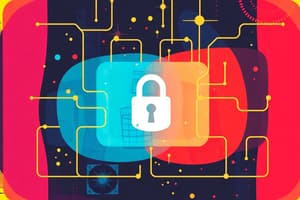Podcast
Questions and Answers
What is the primary function of a firewall in network security?
What is the primary function of a firewall in network security?
- Conduct vulnerability assessments
- Detect and remove malware
- Monitor and filter traffic between networks (correct)
- Encrypt data during transmission
Which technology actively blocks threats after detection?
Which technology actively blocks threats after detection?
- Firewall
- Intrusion Prevention System (IPS) (correct)
- Virtual Private Network (VPN)
- Intrusion Detection System (IDS)
What type of malware is designed to replicate itself and spread to other devices?
What type of malware is designed to replicate itself and spread to other devices?
- Ransomware
- Adware
- Worms (correct)
- Spyware
Which of the following is a common method for granting permissions to resources after verifying identity?
Which of the following is a common method for granting permissions to resources after verifying identity?
What is the primary purpose of a Virtual Private Network (VPN)?
What is the primary purpose of a Virtual Private Network (VPN)?
Which regulatory standard is known for its guidelines on managing cybersecurity risks?
Which regulatory standard is known for its guidelines on managing cybersecurity risks?
Which of the following is an essential practice for maintaining network security?
Which of the following is an essential practice for maintaining network security?
What type of attack aims to make a service unavailable by overwhelming it with traffic?
What type of attack aims to make a service unavailable by overwhelming it with traffic?
Flashcards are hidden until you start studying
Study Notes
Information Technology: Network Security
Definition
- Network security involves measures to protect data during transfer across a network from unauthorized access, misuse, malfunction, destruction, or improper disclosure.
Key Components
-
Firewalls
- Acts as a barrier between trusted and untrusted networks.
- Monitors and filters incoming and outgoing traffic based on security rules.
-
Intrusion Detection Systems (IDS)
- Monitors network traffic for suspicious activity and alerts administrators.
- Can be Host-Based (HIDS) or Network-Based (NIDS).
-
Intrusion Prevention Systems (IPS)
- Similar to IDS but also takes action to block or prevent detected threats.
-
Virtual Private Networks (VPN)
- Provides secure remote access to a network over the internet.
- Encrypts data to enhance privacy during transmission.
-
Encryption
- The process of encoding messages to protect data confidentiality.
- Common protocols include SSL/TLS for web traffic and IPSec for VPNs.
-
Access Control
- Mechanisms to restrict who can access network resources.
- Types:
- Authentication: Verifying user identity (e.g., passwords, biometrics).
- Authorization: Granting permissions to resources after authentication.
-
Antivirus and Anti-Malware
- Software to detect and remove malicious software from systems.
- Regular updates and real-time scanning are essential.
Types of Threats
- Malware: Malicious software designed to damage or disrupt systems (e.g., viruses, worms, ransomware).
- Phishing: Fraudulent attempts to obtain sensitive information by masquerading as trustworthy entities.
- Denial of Service (DoS): Attack aimed at making a service unavailable by overwhelming it with traffic.
- Man-in-the-Middle (MitM): Interception of communication between two parties, often to steal information.
Best Practices
- Keep software and systems updated to patch vulnerabilities.
- Implement strong password policies and multi-factor authentication.
- Regularly back up data to recover from breaches or data loss.
- Conduct security audits and vulnerability assessments.
- Provide employee training on security awareness and practices.
Regulatory Standards
- ISO/IEC 27001: International standard for information security management.
- NIST Cybersecurity Framework: Guidelines for managing cybersecurity risks.
- GDPR: Regulation on data protection and privacy in the European Union that affects network security compliance.
Emerging Trends
- Increased adoption of cloud security measures as more data moves to the cloud.
- Use of artificial intelligence to enhance threat detection and response capabilities.
- Zero Trust Architecture: a security model that assumes threats may be internal and requires verification from all users.
Conclusion
- Network security is vital for protecting data and maintaining the integrity, confidentiality, and availability of information exchanged over networks. Regularly updating security measures and staying informed about new threats and technologies is crucial.
Network Security Definition
- Network security encompasses safeguarding data transferred across networks from unauthorized access, misuse, destruction, malfunction, and improper disclosure.
Key Components
- Firewalls: Act as a barrier between safe and unsafe networks, monitoring and filtering traffic based on security rules.
- Intrusion Detection Systems (IDS): They monitor network traffic for suspicious activity and alert administrators.
- Can be host-based (HIDS) or network-based (NIDS)
- Intrusion Prevention Systems (IPS): Similar to IDS but actively block or prevent detected threats.
- Virtual Private Networks (VPNs): Provide secure remote access to a network through the internet by encrypting data for privacy during transmission.
- Encryption: The process of encoding messages to protect data confidentiality.
- Common protocols include SSL/TLS for web traffic and IPSec for VPNs.
- Access Control: Restricts who can access network resources by verifying user identity through authentication (passwords, biometrics) and granting permissions through authorization.
- Antivirus and Anti-Malware: Software for detection and removal of malicious software from systems.
- Regular updates and real-time scanning are vital.
Types of Threats
- Malware: Harmful software designed to disrupt or damage systems (viruses, worms, ransomware).
- Phishing: Fraudulent attempts to gain sensitive information by impersonating legitimate entities.
- Denial of Service (DoS): Attacks aim to make a service unavailable by overwhelming it with traffic.
- Man-in-the-Middle (MitM): Hijacking of communication between two parties, often to steal information.
Best Practices
- Keep software and systems updated to address vulnerabilities.
- Implement strong password policies and multi-factor authentication.
- Regularly back up data to recover from breaches or data loss.
- Conduct security audits and vulnerability assessments.
- Provide employee training on security awareness and best practices.
Regulatory Standards
- ISO/IEC 27001: International standard for information security management systems.
- NIST Cybersecurity Framework: Guidelines for managing cybersecurity risks.
- GDPR: Regulation on data protection and privacy within the European Union, impacting network security compliance.
Emerging Trends
- Increased adoption of cloud security measures as more data migrates to the cloud.
- The use of artificial intelligence to enhance threat detection and response capabilities.
- Zero Trust Architecture: a security model assuming potential internal threats, requiring verification from all users.
Conclusion
- Network security is crucial for protecting data and maintaining the integrity, confidentiality, and availability of information exchanged over networks.
- Staying updated on security measures and emerging threats and technologies is essential.
Studying That Suits You
Use AI to generate personalized quizzes and flashcards to suit your learning preferences.




